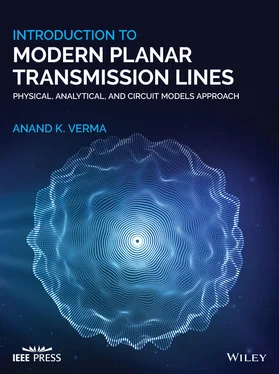Concept of the Magnetic Vector Potential
In the process of discovery of induction, Faraday introduced the concept of fields , and also suggested that the electric energy resides in the field around the charged body and the magnetic energy resides in the field around the magnetized body. Thus, he viewed that the electric and magnetic energies reside in the space around the charged or magnetized body, not in the charge or magnet.
The field concept has greatly influenced the further development of EM‐theory. The field provided a mechanism of interaction between charged bodies. Using Ampere‐Biot–Savart law of magnetic forces, and electromagnetic induction of Faraday, Neumann in 1845 introduced the concept of the magnetic vector potential  to describe the magnetic field. Subsequently, Maxwell showed that the time derivative of
to describe the magnetic field. Subsequently, Maxwell showed that the time derivative of  computes the induced electric field
computes the induced electric field  . Kelvin in 1847 further extended the concept of the magnetic vector potential
. Kelvin in 1847 further extended the concept of the magnetic vector potential  to compute the magnetic field using the relation
to compute the magnetic field using the relation  . This relation comes as a solution of the Gauss divergence equation
. This relation comes as a solution of the Gauss divergence equation  due to the closed‐loop of the magnetic field, showing the nonexistence of a magnetic charge. Kelvin further elaborated on the mathematical theory of magnetism in 1851. It is interesting to note that at any location in the space once time‐dependent magnetic vector potential function is known, both the magnetic and electric fields could be computed as,
due to the closed‐loop of the magnetic field, showing the nonexistence of a magnetic charge. Kelvin further elaborated on the mathematical theory of magnetism in 1851. It is interesting to note that at any location in the space once time‐dependent magnetic vector potential function is known, both the magnetic and electric fields could be computed as,
(1.1.1) 
Maxwell shared the views of Neumann and Kelvin. However, time‐retardation was not incorporated in the scalar and vector potentials. In 1867, Lorentz introduced the concept of retardation in both the scalar and vector potentials to develop the EM‐theory of light, independent of Maxwell. The time‐retardation only in the scalar potential was first suggested by Riemann in 1858, but his work was published posthumously in 1867 [J.1, J.2, B.6, B.7].
Maxwell's Dynamic Electromagnetic Theory
At this stage of developments in the EM‐theory, the electric field was described in terms of the scalar electric potential, and the magnetic field was described by the magnetic vector potential. Several laws were in existence, such as Faraday's law, Ampere's law, Gauss's law, and Ohm's law. Now Maxwell, Newton of the EM‐theory, arrived at the scene to combine all the laws in one harmonious concept, i.e. in the Dynamic Electromagnetic Theory . He introduced the brilliant concept of the displacement current, created not by any new kind of charge but simply by the time‐dependent electric field. Unlike the usual electric current supported by a conductor, this new current was predominantly supported by the dielectric medium. However, both currents were in a position to generate the magnetic fields. Thus, Maxwell modified Ampere's circuital law by incorporating the displacement current in it. The outcome was dramatic; the electromagnetic wave equation . Despite such success, the concept and physical existence of displacement current created a controversy that continues even in our time, and its measurement is a controversial issue [J.6–J.8].
In the year 1856, Maxwell formulated the Faraday's law of induction mathematically, and modified Ampere's circuital law in 1861 by adding the displacement current to it. Finally in 1865 after a time lag of nearly 10 years, Maxwell could consolidate all available knowledge of the electric and magnetic phenomena in a set of 20 equations with 20 unknowns. However, he could solve the equations to get the wave equations for the EM‐wave with velocity same as the velocity of light. Now, the light became simply an EM‐wave. In the year 1884, Heaviside reformulated the Maxwell equations in a modern set of four vector differential equation. The new formulation of Maxwell equations was in terms of the electric and magnetic field quantities and completely removed the concept of potentials, considering them unnecessary and unphysical. Hertz has independently rewritten the Maxwell equation in the scalar form using 12 equations without potential function. Hertz worked out these equations only after Heaviside. In 1884, Poynting computed the power transported by the EM‐waves. Recognizing the contributions of both Heaviside and Hertz in reformulating Maxwell's set of equations, Lorentz called the EM‐fields equations Maxwell–Heaviside–Hertz equations . However, in due course of time, the other two names were dropped and the four‐vector differential equations are now popularly known as “ Maxwell’s Equations” [J.1, J.6, J.9, J.10, B.5–B.7].
Generation and Transmission of Electromagnetic Waves
Maxwell's EM‐theory was a controversial theory, and physicists such as Kelvin never accepted it. Hertz finally generated, transmitted, and detected the EM‐waves in 1887 at wavelengths of 5 m and 50 cm. In the process, he invented the loaded dipole as the transmitting antenna, rectangular wire‐loop receiving antenna , and spark‐gap both as transmitter and detector to detect the propagated EM-waves. Thus, he experimentally confirmed the validity of Maxwell equations and opened the magnificent gateway of wireless communication.
In the year 1895, Marconi transmitted and received a coded telegraphic message at a distance of 1.75 miles. Marconi continued his works and finally on December 12, 1901, he succeeded in establishing the 1700 miles long‐distance wireless communication link between England and Canada. The transmission took place using the Hertzian spark‐gap transmitter operating at the wavelength of 366m. In the year 1895 itself, J.C. Bose generated, transmitted, and detected the 6 mm EM‐wave. He used circular waveguide and horn antenna in his system. In 1897, Bose reported his microwave and mm‐wave researches in the wavelengths ranging from 2.5 cm to 5 mm at Royal Institution, London. Of course, the Hertzian spark‐gap transmitter was at the core of his communication system. Bose was much ahead of his time as the commercial communication system grew around the low frequency, and the microwave phase of communication was yet to come in the future. In 1902, Max Abraham introduced the concept of the radiation resistance of an antenna [J.11–J.13, B.1–B6].
Further Information on Potentials
Hertz is known for his outstanding experimental works. However, as a student of Helmholtz, he was a high ranking theoretical physicist. Although, he considered, like Heaviside, electric and magnetic fields as the real physical quantities, still he used the vector potentials, now called Hertzian potentials  and
and  , to solve Maxwell's wave equation for the radiation problem. These potentials are closely related to the electric scalar potential ϕ and magnetic vector potential
, to solve Maxwell's wave equation for the radiation problem. These potentials are closely related to the electric scalar potential ϕ and magnetic vector potential  . Stratton further used Hertzian potentials in elaborating the EM‐theory [B.8]. Collin continued the use of Hertzian potentials for the analysis of the guided waves. He also used the
. Stratton further used Hertzian potentials in elaborating the EM‐theory [B.8]. Collin continued the use of Hertzian potentials for the analysis of the guided waves. He also used the  and ϕ potentials in the radiation problems [B.9, B.10]. The use of Hertzian potentials gradually declined. However, its usefulness in problem‐solving has been highlighted [J.1, J.11, J.12].
and ϕ potentials in the radiation problems [B.9, B.10]. The use of Hertzian potentials gradually declined. However, its usefulness in problem‐solving has been highlighted [J.1, J.11, J.12].
Читать дальше

 to describe the magnetic field. Subsequently, Maxwell showed that the time derivative of
to describe the magnetic field. Subsequently, Maxwell showed that the time derivative of  computes the induced electric field
computes the induced electric field  . Kelvin in 1847 further extended the concept of the magnetic vector potential
. Kelvin in 1847 further extended the concept of the magnetic vector potential  to compute the magnetic field using the relation
to compute the magnetic field using the relation  . This relation comes as a solution of the Gauss divergence equation
. This relation comes as a solution of the Gauss divergence equation  due to the closed‐loop of the magnetic field, showing the nonexistence of a magnetic charge. Kelvin further elaborated on the mathematical theory of magnetism in 1851. It is interesting to note that at any location in the space once time‐dependent magnetic vector potential function is known, both the magnetic and electric fields could be computed as,
due to the closed‐loop of the magnetic field, showing the nonexistence of a magnetic charge. Kelvin further elaborated on the mathematical theory of magnetism in 1851. It is interesting to note that at any location in the space once time‐dependent magnetic vector potential function is known, both the magnetic and electric fields could be computed as,
 and
and  , to solve Maxwell's wave equation for the radiation problem. These potentials are closely related to the electric scalar potential ϕ and magnetic vector potential
, to solve Maxwell's wave equation for the radiation problem. These potentials are closely related to the electric scalar potential ϕ and magnetic vector potential  . Stratton further used Hertzian potentials in elaborating the EM‐theory [B.8]. Collin continued the use of Hertzian potentials for the analysis of the guided waves. He also used the
. Stratton further used Hertzian potentials in elaborating the EM‐theory [B.8]. Collin continued the use of Hertzian potentials for the analysis of the guided waves. He also used the  and ϕ potentials in the radiation problems [B.9, B.10]. The use of Hertzian potentials gradually declined. However, its usefulness in problem‐solving has been highlighted [J.1, J.11, J.12].
and ϕ potentials in the radiation problems [B.9, B.10]. The use of Hertzian potentials gradually declined. However, its usefulness in problem‐solving has been highlighted [J.1, J.11, J.12].










